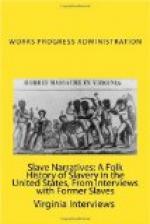Hear the trumpet sound,
Stand up and don’t sit down,
Keep steppin’ ’round and ’round,
Come jine this elegant band.
If you don’t step up and jine the
bout,
Old Missus sure will fine it out,
She’ll chop you in the head wid
a golen ax,
You never will have to pay da tax,
Come jine the roust-a-bout band.”
From roust-a-bout George became a cabin boy, cook, pilot, and held a number of positions on boats, plowing different streams. There was much wild game to be had and the hunting season was always open. He also remembers many wolves, wild turkeys, catamounts and deer in abundance near the Grand River. “Pet deer loafed around the milking pens and ate the feed from the mangers” said he.
George Fortman is a professor of faith in Christ. He was baptized in Concord Lake, seven miles from Clarksville, Tennessee, became a member of the Pleasant Greene Church at Callwell, Kentucky and later a member of the Liberty Baptist Church at Evansville.
“I have always kept in touch with my white folks, the George family,” said the man, now feeble and blind. “Four years ago Mistress Puss died and I was sent for but was not well enough to make the trip home.”
Too young to fight in the Civil War, George was among those who watched the work go on. “I lived at Smiths Landing and remember the battle at Fort Donnelson. It was twelve miles away and a long cinder walk reached from the fort for nearly thirty miles. The cinders were brought from the iron ore mills and my mother and I have walked the length of it many times.” Still reviewing the long, dark trail he continued. “Boatloads of soldiers passed Smith’s Landing by day and night and the reports of cannon could be heard when battles were fought. We children collected Munnie balls near the fort for a long time after the war.”
Although the George family never sold slaves or separated Negro families, George Fortman has seen many boats loaded with slaves on the way to slave marts. Some of the George Negroes were employed as pilots on the boats. He also remembers slave sales where Negroes were auctioned by auctioneers, the Negroes stripped of clothes to exhibit their physique.
“I have always been befriended by three races of people, the Caucassian, the African, and the Negro,” declares George Fortman. “I have worked as a farmer, a river man, and been employed by the Illinois Central Railroad Company and in every position I have held I have made loyal friends of my fellow workmen.” One friend, treasured in the memory of the aged ex-slave is Ollie James, who once defended George in court.




